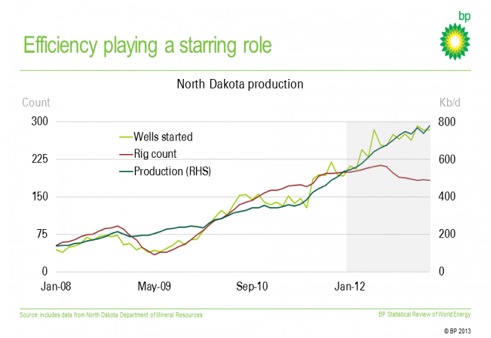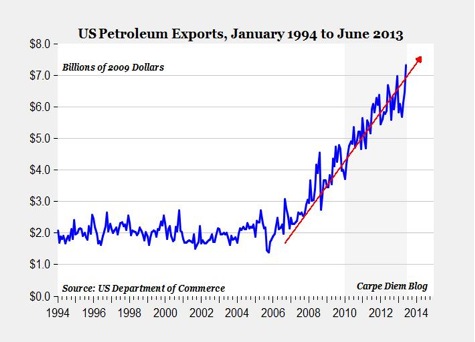The Energy Information Administration (EIA) reports that the China is expected to surpass the United States in oil imports this October and to lead the world in total oil imports in 2014.[i] As the graph below shows, the United States, on a net basis (imports less exports), has decreased its net oil imports fairly dramatically over the last several years. There are several reasons for this decline. Most importantly, U.S. oil production is up. But, other reasons include increased exports of petroleum products, lower or flat liquid fuels demand, and biofuels production that has generally been increasing. China, unlike the United States, has a heavily growing demand for petroleum products and much lower production growth.
Source: Energy Information Administration, http://www.eia.gov/todayinenergy/detail.cfm?id=12471
China’s Liquid Fuels Supply and Demand
According to EIA’s Short-Term Energy Outlook, China’s liquid fuels consumption is expected to increase by 13 percent between 2011 and 2014 to over 11 million barrels per day. But, over this same time period, China’s oil production is expected to increase by just 6 percent to 4.57 million barrels per day. That level of oil production is about one-third of U.S. production in 2014. Thus, China’s imports are expected to average 6.57 million barrels per day for 2014.
U.S. Liquid Fuels Supply and Demand
U.S. liquid fuels consumption has decreased from its peak level in 2005 of 20.8 million barrels per day to 18.6 million barrels per day in 2012, a 10.5 percent decrease. EIA expects U.S. liquid fuels consumption to remain around 18.7 million barrels per day in 2013 and 2014. U.S. oil production has been increasing since 2008 and in 2012 averaged 6.5 million barrels per day. Last year, the United States led the world in having the world’s largest increase in oil production. The United States also had the biggest oil production increase in its history in 2012 even though U.S. oil production began over a century ago in 1859. That increase was due to hydraulic fracturing and directional drilling technology that made it economic to produce tight oil from shale formations.
Most of the increased production came from Texas and North Dakota, the top 2 state producers of oil. Texas oil production almost doubled over the past 5 years. North Dakota’s oil production grew by over 50 percent in 2012. Oil producers in the United States are becoming more efficient getting more oil out of the ground with less rig activity. In North Dakota, for example, the number of new wells started in 2012 increased by over 50 percent and the number of rigs increased by just 10 percent.[ii]
Source: Business Insider, http://www.businessinsider.com/us-to-replace-saudi-arabia-as-largest-oil-producer-2013-8
Besides oil production, domestic supply of liquid fuels includes other components: natural gas plant liquids, which averaged a high 2.4 million barrels per day in 2012; biofuels production, which averaged almost 1 million barrels per day; and refinery processing gain, which added another 1 million barrels per day, bringing total domestic supply of liquid fuels to 11 million barrels per day in 2012. EIA expects U.S. liquid fuels supply to grow about 1 million barrels per day each in 2013 and 2014, bringing the total to about 13 million barrels per day in 2014. As a result, U.S. net imports are expected to average around 5.7 million barrels per day in 2014.
U.S. gross imports of liquid fuels peaked in 2005 at 13.7 million barrels per day. In 2012, they averaged 10.6 million barrels per day. However, the United States has been exporting an increasing amount of liquid fuel products, which have increased from an average of 1.2 million barrels per day in 2005 to 3.2 million barrels per day in 2012, bringing net imports down from 12.5 million barrels per day in 2005 to 7.4 million barrels per day in 2012. That 41 percent reduction in net oil imports is huge—it is larger than Japan’s entire oil consumption last year. Japan is the world’s third largest consumer of petroleum products.
Since 2007, U.S. exports of petroleum products have tripled (in 2009 dollars) reaching a new record high in June. (See chart below.) President Obama has a goal to double total U.S. trade exports between 2010 and 2015, and petroleum products have already met that goal. In January 2010, the United States sold $3.7 billion of petroleum products to the rest of the world and in June 2013, U.S. refineries sold $7.33 billion of petroleum products.[iii]
Source: http://www.aei-ideas.org/wp-content/uploads/2013/08/oilexports.jpg
Conclusion
The U.S. success story is not an accident. Clearly, we have a large technically recoverable resource base and a competitive environment where oil companies are encouraged to take a risk. On private and state land, where this growth is taking place, state regulation allows for increased production and protection of the environment. That coupled with prices high enough to cover development and production costs have created an environment conducive to increased oil production.
Increased oil production with flat or declining liquids fuel demand has resulted in lower net imports and increased liquid fuel exports. These petroleum exports are helping President Obama’s goal to double total U.S. trade exports between 2010 and 2015. But, even with booming fossil fuel exports, it does not look like President Obama will attain his export goal. U.S. exports totaled $1.6 trillion in 2009 and increased by only $600 billion over the next three years (less than 40 percent); they totaled $2.2 trillion in 2012.[iv]
Increased oil production, decreased petroleum imports, and increased petroleum exports are all due to the shale oil revolution in the United States, which has been one of the major bright spots in U.S. energy supply and American technology.
[i] Energy Information Administration, China poised to become the world’s largest net oil importer later this year, August 9, 2013, http://www.eia.gov/todayinenergy/detail.cfm?id=12471
[ii] Business Insider, The US is well on its way to replace Saudi Arabia as the world’s largest oil producer, August 9, 2013, http://www.businessinsider.com/us-to-replace-saudi-arabia-as-largest-oil-producer-2013-8
[iii] American Enterprise Institute, In 2010, Obama promised to double exports in 5 years. A completely unrealistic goal — except for petroleum products, August 7, 2013, http://www.aei-ideas.org/2013/08/in-2010-obama-promised-to-double-exports-in-5-years-a-completely-unrealistic-goal-except-for-petroleum-products/?cmpid=eefl
[iv] Fuel Fix, Obama falling short on exports, but fuel shipments booming, August 8, 2013, http://fuelfix.com/blog/2013/08/08/obama-falling-short-on-exports-but-fuel-shipments-booming/






